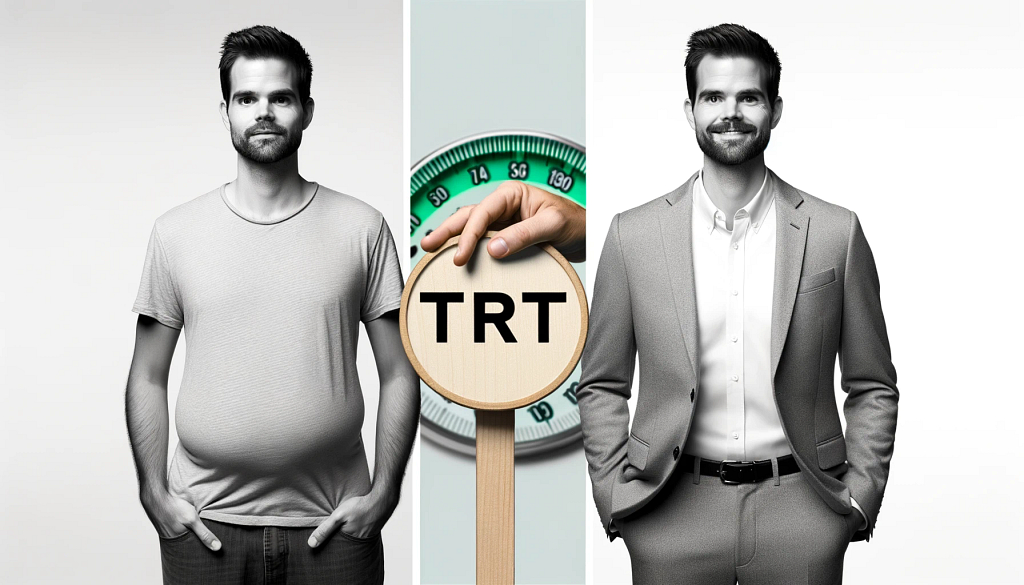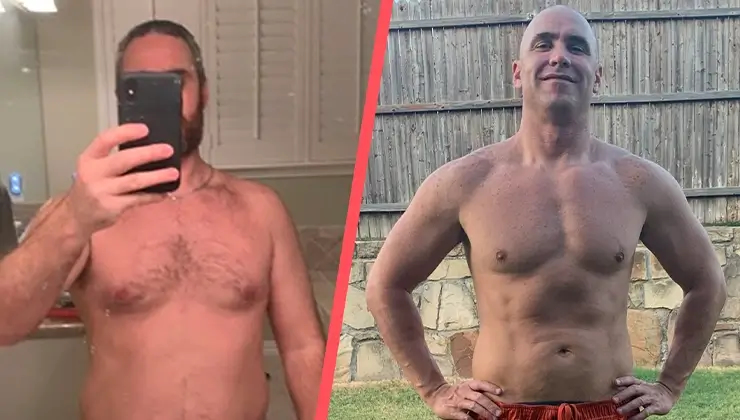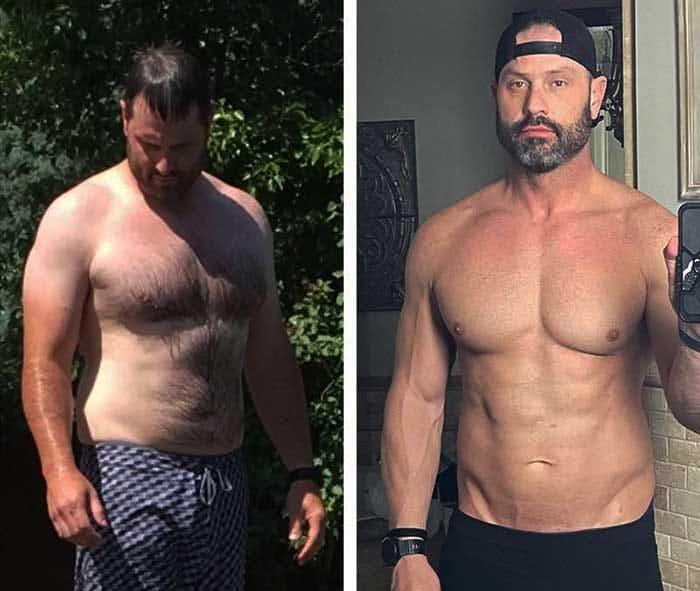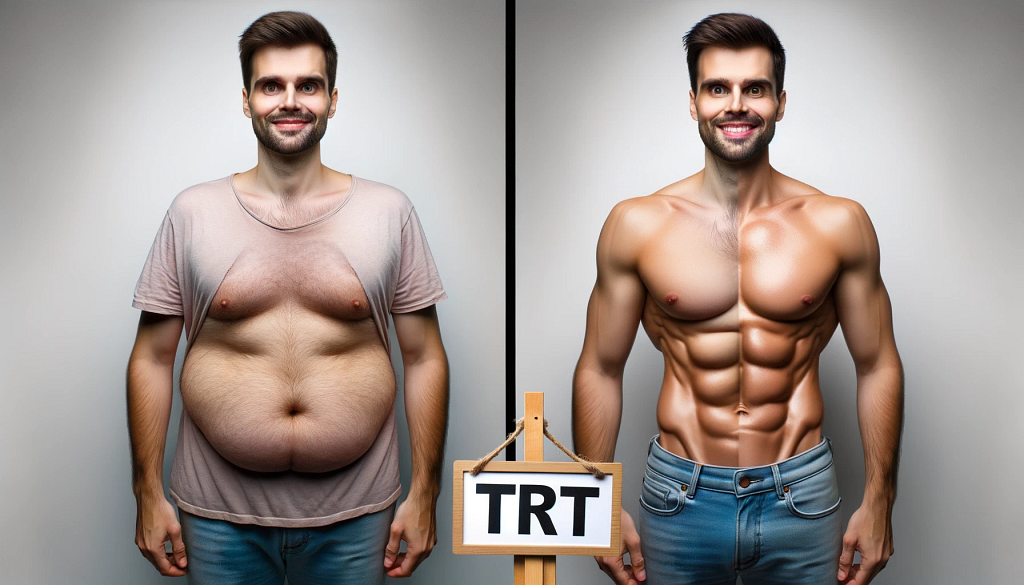Testosterone Replacement Therapy (TRT) is a medical treatment aimed at addressing low testosterone levels in men, which can result in various physical and mental symptoms. Testosterone is a hormone responsible for many vital functions in the male body, including muscle growth, bone density, and libido. With age or certain medical conditions, testosterone levels may decrease, leading to a need for supplementation through TRT.

Before beginning TRT, it is essential to consult a healthcare professional to evaluate individual symptoms, potential benefits, and possible risks associated with the treatment. This evaluation usually consists of blood tests and symptom assessment. The TRT journey varies from person to person, but many individuals experience significant improvements in their overall well-being, such as increased muscle mass, improved mood, and enhanced energy levels. These changes typically manifest within the first few months of undergoing therapy.
Understanding the before and after effects of TRT can provide valuable insight into the potential advantages and challenges associated with this treatment. By delving deeper into these transformations, one can make informed decisions regarding the management of their testosterone levels and overall health.

Understanding TRT
Testosterone Replacement Therapy (TRT) is a medical treatment prescribed to individuals who have low testosterone levels. It aims to bring hormone levels back to a healthy range, promoting overall physical and mental well-being. The therapy consists of administering testosterone through various forms such as injections, gels, or patches.
The primary goal of TRT is to alleviate symptoms of low testosterone, such as decreased energy, muscle mass, sexual function, and mood swings. Individuals undergoing TRT can experience significant improvements in various aspects of their life. For example, TRT can lead to increased energy levels and vitality, better muscle mass and tone, enhanced sexual function, and improved mood stability.
It is essential to understand that TRT is not a one-size-fits-all treatment. The dosage, method of administration, and duration depend on the individual’s specific needs and hormone levels. Regular monitoring of testosterone levels and follow-up appointments with healthcare providers are necessary to ensure the therapy’s safety and effectiveness. Adverse effects of TRT can occur when improperly managed, so it is crucial to work closely with a specialist to design an appropriate treatment plan.
The Endocrine Society provides guidelines for diagnosing and treating low testosterone. They recommend measuring testosterone levels in individuals with symptoms of low testosterone and confirming the diagnosis with repeat testing. The Society also advises considering the potential risks and benefits before starting TRT and emphasizes the importance of regularly monitoring the patient’s response to treatment.
In conclusion, TRT can be a highly beneficial treatment for individuals with low testosterone levels, helping to restore hormone balance, improve physical and mental health, and enhance the overall quality of life. Adhering to established guidelines and working with specialists ensure that TRT is safe and effective, leading to meaningful improvements in the patient’s well-being.

Before Starting TRT
Before starting testosterone replacement therapy (TRT), it is crucial to understand the reasons why an individual might need this treatment. Low testosterone, also known as hypogonadism or testosterone deficiency, can occur due to various factors, including age, genetics, and underlying medical conditions. Common symptoms of low testosterone may include fatigue, mood swings, decreased libido, and muscle loss.
It is essential to consult a doctor to discuss potential symptoms of low testosterone before initiating TRT. Proper testing, which may include blood tests to measure hormone levels, can help determine if a person has hypogonadism or another underlying health condition contributing to their symptoms. A medical professional will evaluate a patient’s symptoms, overall health status, and medical history to determine if TRT is appropriate for them.
Age plays a crucial role in testosterone levels, as they tend to decrease naturally as men age. However, not all older men experience significant symptoms from age-related testosterone decline. It is essential to differentiate between natural aging processes and actual testosterone deficiency requiring treatment.
In the context of hypogonadism, low testosterone levels could result from either primary (testicular dysfunction) or secondary (pituitary or hypothalamic dysfunction) causes. Knowing the underlying cause can help determine the most effective treatment approach. Treating the root cause of low testosterone when possible, such as lifestyle changes or addressing other medical issues, may alleviate symptoms without resorting to TRT.
Keep in mind that TRT is not suitable for everyone experiencing symptoms of low testosterone. Some individuals may be ineligible for treatment due to pre-existing medical conditions or potential risks associated with hormone replacement therapy. A doctor will assess the individual’s specific situation and determine whether the potential benefits of TRT outweigh the risks.
In conclusion, it is essential to thoroughly evaluate the symptoms, causes, and potential risks before starting TRT. Proper assessment by a healthcare professional and adherence to prescribed treatment plans help optimize outcomes and minimize risks associated with testosterone replacement therapy.

Symptoms of Low Testosterone
Low testosterone can manifest in various ways, impacting both physical and mental health. Some of the common symptoms include:
- Fatigue: Individuals with low testosterone often experience persistent exhaustion and a lack of energy, even when they get adequate amounts of sleep. This can hinder daily activities and overall quality of life.
- Low libido: Testosterone is a crucial hormone for sexual desire. Thus, a decrease in testosterone levels can lead to a reduced interest in sex, making it challenging to maintain intimate relationships.
- Depression: Low testosterone is also associated with an increased risk of depression. Individuals may have persistent feelings of sadness, hopelessness, or a lack of motivation to engage in activities they previously enjoyed.
- Irritability: Mood swings and irritability are common in those with low testosterone, often leading to increased stress and tension in personal and professional relationships.
- Increased body fat: Low testosterone can affect body composition, contributing to an increase in body fat, particularly around the abdomen. This can further impact overall health and wellbeing.
- Brain fog: Individuals with low testosterone may struggle with cognitive functioning, including memory, concentration, and decision-making – often referred to as brain fog.
- Sexual dysfunction: Apart from reduced libido, sexual dysfunction such as erectile dysfunction and diminished sperm count can be a consequence of low testosterone levels, making it difficult for some individuals to achieve or maintain erections or conceive children.
It is essential to consult with a healthcare professional if you experience any of these symptoms, as they could be indicative of low testosterone levels. A medical evaluation can help determine the appropriate course of action, including potential treatment options like Testosterone Replacement Therapy (TRT).

TRT Treatment Options
Testosterone Replacement Therapy (TRT) is an effective treatment for individuals with low testosterone levels. Multiple treatment options exist, allowing patients and healthcare providers to choose the best method suitable for individual needs and preferences. This section will discuss the various TRT treatment options, which include injections, gels, patches, anabolic steroids, and exogenous testosterone.
Injections are a common and reliable method for administering TRT. Testosterone injections typically occur once every two to four weeks, depending on the patient’s needs and the specific formulation being used. Injections deliver a consistent dose of testosterone directly into the muscle tissue, ensuring adequate absorption and distribution throughout the body. However, some individuals may find injections uncomfortable or inconvenient due to the need for regular visits to a healthcare provider.
Gels offer a topical TRT option, providing a convenient and non-invasive way to administer testosterone. Patients apply gels directly to the skin, usually on the shoulders or upper arms, where they are absorbed into the bloodstream. Gels may need to be applied daily, and users should be careful to avoid skin-to-skin contact with others to prevent the transfer of testosterone.
Patches function similarly to gels, delivering testosterone through the skin. Patches are discreet and easy to use, typically applied to various areas such as the back, abdomen, or thigh. They release a steady dose of testosterone over 24 hours, then must be replaced with a fresh patch. However, some patients may experience skin irritation or discomfort at the application site.
Anabolic steroids are synthetic substances with properties similar to testosterone, used to promote muscle and bone growth. However, anabolic steroids are not a recommended TRT treatment option due to their potential for severe side effects and the risk of abuse. These substances should only be used under medical supervision, and primarily for conditions unrelated to low testosterone.
Exogenous testosterone refers to the administration of testosterone from an external source, rather than promoting its natural production within the body. All TRT treatments, including injections, gels, and patches, utilize exogenous testosterone to supplement the body’s natural hormone levels, improve symptoms, and restore hormonal balance.
In conclusion, a variety of TRT treatment options are available to address the needs and preferences of individuals with low testosterone levels. Patients should consult with their healthcare provider to determine the most suitable method for their unique situation.

Diet and Exercise During TRT
A well-balanced diet and regular exercise routine are crucial components during Testosterone Replacement Therapy (TRT) to maximize its benefits. As TRT aims to improve strength, muscle mass, and overall quality of life, these lifestyle adjustments promote better results.
Diet Recommendations While on TRT, it is essential to consume nutrient-dense foods that support hormone production and overall health. A balanced diet should include:
- Fruits
- Vegetables
- Whole grains
- Lean proteins
- Healthy fats
These foods provide your body with essential nutrients to function optimally and improve the effects of TRT. Though supplements are not necessary, some may help support testosterone production and overall health. Be sure to consult with your healthcare provider before adding any supplements to your routine.
Exercise Guidelines In addition to following a healthy diet, incorporating regular exercise into your routine can enhance the results of TRT. According to OHMG, engaging in weight lifting or resistance training with machines 3-4 times per week for approximately one hour each session is an excellent way to optimize TRT benefits.
Exercise has been shown to improve muscle mass, strength, and overall health, all of which are essential factors in the success of TRT. As you progress through your therapy, you may notice an increase in motivation, energy levels, and even improvements in mental health.
In conclusion, for individuals undergoing TRT, a healthy diet and consistent exercise routine can lead to better results. By following these recommendations, you can experience increased muscle mass, improved strength, and overall enhanced quality of life.

Changes After TRT
Physical Changes
TRT is known for bringing about several physical changes in individuals undergoing the treatment. One of the primary changes is an increase in muscle mass, which is often accompanied by an improvement in overall strength. This allows individuals to perform better in various physical activities and maintain a more youthful, toned appearance.
Moreover, TRT can lead to increased energy levels, a key requirement for a healthy and active lifestyle. With enhanced energy, individuals often find it easier to tackle daily tasks and engage in regular exercise, ultimately leading to better weight management.
Another significant physical change involves body composition, specifically, with regards to fat loss and lean muscle development. TRT contributes to a decrease in body fat, promoting a leaner physique. This results in improvements in overall body tone, making individuals appear more fit and healthy.
Psychological Changes
In addition to physical transformations, TRT can also have a positive impact on an individual’s psychological well-being. One noticeable change is the enhancement of libido, which can greatly improve one’s overall sexual health and satisfaction. This increased sex drive can also have a positive effect on an individual’s mood and self-esteem, further contributing to their overall well-being.
Furthermore, TRT has been reported to alleviate symptoms like fatigue and mood swings, helping individuals feel more energized and emotionally stable. These psychological changes can contribute to improved overall mental health, as well as a more satisfying and fulfilling life experience.
Possible Side Effects
Testosterone replacement therapy (TRT) has helped many individuals improve their quality of life. However, like any medical treatment, it is essential to be aware of the possible side effects. Some common side effects include acne, hair loss, and enlarged prostate. It is crucial to discuss these potential side effects with a healthcare professional before starting TRT.
One common side effect of TRT is acne or oily skin, which can be caused by increased testosterone levels. Higher testosterone levels stimulate the sebaceous glands, leading to the production of more oil, which can ultimately result in acne. It is essential to maintain proper hygiene and consult with a dermatologist if acne becomes a significant concern during TRT.
Another possible side effect is hair loss, which may occur due to the impact of increased testosterone on the hair follicles. Testosterone can be converted to dihydrotestosterone (DHT), which can cause hair follicles to shrink, resulting in hair thinning or loss. However, hair loss is not guaranteed and varies from person to person.
Enlarged prostate is another potential side effect of TRT. Testosterone can stimulate the growth of prostate tissue, which may lead to an enlarged prostate, causing urinary issues and discomfort. Regular monitoring of prostate health by a healthcare professional is recommended for individuals undergoing TRT.
Apart from the discussed side effects, TRT may also increase the risk of more severe complications such as blood clots, heart attack, and stroke. These risks may be higher in individuals with existing health conditions. It is essential for anyone considering TRT to discuss these risks with their healthcare provider and closely monitor their health throughout the treatment.
In conclusion, TRT can offer numerous benefits, but it also comes with potential side effects and risks. It is crucial for individuals undergoing TRT to be aware of these side effects and collaborate with their healthcare provider to develop a safe and effective treatment plan.

Assessing TRT Effectiveness
When evaluating the effectiveness of Testosterone Replacement Therapy (TRT), it is essential to measure various factors, including testosterone levels, blood tests, overall health, and the perceived benefits of TRT.
One of the primary indicators of TRT effectiveness is the improvement in testosterone levels. Testosterone levels can be measured through regular blood tests during the course of treatment. The goal is to bring the testosterone levels within the physiological range, which may vary depending on the patient’s age and overall health.
Blood tests are crucial in monitoring the progress of TRT and assessing any potential side effects. In addition to testosterone levels, the tests should also track hematocrit, prostate-specific antigen (PSA), and lipid levels, among other crucial health markers. Regular monitoring can help the healthcare professional make adjustments to the treatment, if necessary, and ensure the safety of the patient.
The overall health of a patient is a useful gauge of the effectiveness of TRT. Improved health indicators may include increased muscle mass, decreased body fat, better mood, and enhanced cognitive function. However, it is crucial to remember that TRT may not address all health issues in every patient, and a more comprehensive approach to their care may be necessary.
The benefits of TRT can vary from person to person but generally include increased energy levels, improved sexual function, and better mood. These improvements may become noticeable within weeks or months of starting TRT, but the results may differ based on the individual’s initial testosterone levels, age, and overall health status.
In summary, assessing the effectiveness of TRT requires regular monitoring of testosterone levels, blood tests, overall health, and the perceived benefits of the therapy. This information can help healthcare professionals tailor the treatment to the individual needs of each patient while ensuring safety and the best possible outcomes.

Health Risks Concerning TRT
Testosterone Replacement Therapy (TRT) has been a topic of discussion in the medical community, as it offers potential benefits to patients with low testosterone levels. However, it’s crucial to understand the potential health risks associated with this treatment.
One of the primary concerns with TRT is its potential link to prostate cancer. Although there is not enough evidence to establish a direct relationship between TRT and prostate cancer, some studies suggest that long-term use of TRT may increase the risk in men with already low testosterone levels 1. It’s essential for individuals considering TRT to consult their healthcare providers and discuss the potential risks associated with this treatment.
Heart disease and congestive heart failure are other potential health risks associated with TRT. A meta-analysis reported that men who had been on TRT for more than 16 months had a lower risk for cardiac events and prostate cancer than men who had been on it for less time (or not at all) 2. However, a more recent study found that TRT significantly reduced the risk for heart attack and stroke in men with low testosterone levels 3. The relationship between TRT and heart health remains an area of ongoing research.
TRT can have some impact on bone health, affecting the development of osteoporosis in certain cases. A balanced approach to TRT is essential, as both low and high testosterone levels can negatively impact bone density, leading to an increased risk of fractures 4. Regular monitoring and adjusting of TRT dosages can help maintain optimal bone health.
In terms of reproductive health, TRT may contribute to infertility due to a decrease in sperm count as a possible side effect. Testosterone supplementation can cause the hypothalamus and pituitary gland to slow down natural testosterone production, which in turn leads to a reduction in sperm production 5. This can result in infertility, especially if a patient’s TRT dosage is not carefully managed.
Lastly, TRT may have varying effects on sexual function. While some patients observe improvements in libido and sexual performance, others may experience complications or no noticeable change. Patients must discuss possible side effects on sexual function with their healthcare providers before commencing TRT.
In summary, while TRT can offer benefits to individuals with low testosterone levels, it’s crucial to be aware of the potential health risks associated with this treatment. Consulting a healthcare professional is vital to ensure a safe and effective approach to TRT.

Things to Consider When Starting TRT
When considering testosterone replacement therapy (TRT), it’s essential to weigh several factors to make an informed decision. One such factor is the cost of the treatment, which can vary depending on the type, dosage, and frequency of the prescribed TRT method. Keep in mind that insurance coverage may also play a role in the overall cost.
Another aspect to consider is the commitment required for successful treatment. TRT is not a one-time solution but rather an ongoing regimen, which typically involves regular injections, patches, or gels. Patients should be prepared to maintain a consistent schedule and adhere to their treatment plan under the guidance of a healthcare professional.
Speaking of a treatment plan, it’s crucial to have a personalized approach when starting TRT. Each patient’s needs vary, and a licensed physician must oversee the therapy process to ensure hormonal balance. This process may involve thorough blood work to monitor red blood cell counts, blood lipids, prostate-specific antigen, and other relevant biomarkers for optimal results1.
In terms of safety and potential risks, TRT has some side effects, such as acne, oily skin, lower sperm count, increased risk of blood clots, shrinkage of the testicles, and larger breasts2. It is crucial to discuss these potential side effects with a medical professional, who will help patients weigh the benefits and risks to make the best decision for their health.
Lastly, the ultimate goal of TRT is to improve overall wellness and manage symptoms related to low testosterone levels. Testosterone replacement therapy has been shown to have positive effects on mood stability, emotional well-being, energy levels, and vitality3. By considering these factors, individuals can make informed decisions about whether TRT is the right choice for their hormone therapy needs.

Impact of TRT on Sexual Health
Testosterone Replacement Therapy (TRT) has been increasingly popular in addressing various issues related to aging, including sexual health. TRT can have a significant impact on sexual health aspects like erectile dysfunction, libido, sexual desire, sex drive, and sexual function.
Among the primary benefits of TRT is its efficacy in improving erectile function. Men with low testosterone levels often experience erectile dysfunction, which negatively impacts their quality of life. TRT helps to boost testosterone levels, ultimately supporting better erectile function and enabling them to lead a more satisfying sex life.
Another key area where TRT has a substantial impact is on an individual’s sex drive or libido. Testosterone decline is a natural part of aging and often results in reduced sexual desire. By replenishing testosterone levels through TRT, men experience a resurgence of sexual desire and an overall improvement in their sexual wellness.
In addition to improving erectile function and boosting libido, TRT also contributes to enhanced sexual function. This includes factors such as sexual endurance, overall performance, and the body’s responsiveness to sexual stimuli. TRT helps to ensure that individuals can fully enjoy and engage in sexual activity as they age.
One important aspect to consider is that while TRT can positively affect these areas of sexual health, it is crucial to consult a healthcare professional before beginning any treatment. They can determine if TRT is the appropriate solution for improving sexual health based on an individual’s unique circumstances and medical history.
Overall, TRT has the potential to greatly influence an individual’s sexual health by addressing erectile dysfunction, increasing sexual desire, and improving overall sexual function. With proper care and supervision, TRT can provide an effective solution for men experiencing the impact of low testosterone on their sexual wellbeing.

Personal Experiences with TRT
Experiences from Online Communities
Online communities, such as Reddit, provide a platform for individuals to share their personal experiences with TRT (testosterone replacement therapy) before and after their journey. These forums are filled with discussions about the benefits and potential side effects of the treatment. People often share their personal stories, detailing their struggles with low testosterone and the positive changes they’ve experienced after starting TRT.
One noticeable trend in these online communities is that many users report experiencing increased energy levels, improved mood, and mental clarity after beginning TRT. Many individuals also mention positive physical changes, such as increased muscle mass, decreased body fat, and improvements in their overall physical performance. Additionally, improved libido and sexual performance are commonly reported benefits among participants.
Firsthand Accounts from Users
Several firsthand accounts of TRT users provide valuable insight into the individual journeys of those undergoing the treatment process. In one testimony, a user describes how their motivation and energy improved just two to three weeks into the treatment. Their mental clarity also increased, signifying the therapy’s positive effects on cognitive functions.
Another story highlights the beneficial impact of TRT on cardiovascular health, insulin sensitivity, and mental health. These effects collectively lead to a better quality of life for the individual, as they feel more like a “normal man again.”
In a different account, a patient reports significant improvements in sexual performance after 10-12 weeks of TRT. They felt that their before and after results were readily apparent, showcasing the potential benefits of the therapy when properly administered and monitored.
While personal experiences with TRT can vary, these candid accounts demonstrate the potential positive effects of hormone replacement therapy on both physical and mental aspects of an individual’s life. As always, it’s crucial for those considering TRT to consult a healthcare professional to understand the potential risks and benefits, as well as the most suitable treatment option for their specific situation.

Frequently Asked Questions
What is the typical timeline for TRT results?
The timeline for TRT results can vary depending on the individual, the dosage, and the specific goals of treatment. However, some general milestones can be observed. Soon after the first injection, some individuals may experience improved mood and energy levels. Noticeable changes in body composition, such as increased muscle mass and reduced body fat, can occur within the first 3 months of therapy. It may take 6 months to a year for the full benefits of TRT to be realized, with continued improvements potentially occurring for several years with consistent therapy. source
Are there any notable benefits of TRT for individuals over 50 years old?
Yes, there are notable benefits of TRT for individuals over 50 years old. TRT can help maintain and improve bone density, which is particularly important for older adults who may be at risk for osteoporosis. Other potential benefits include improvements in mood, energy levels, libido, and cognitive function. source
How soon can changes be observed after starting TRT?
Though individual experiences may vary, some changes may be observed within the first week of TRT therapy, such as improvements in mood and energy levels. However, more significant changes, like muscle growth and fat loss, typically occur within the first 3 months of consistent therapy. source
What are the common effects of TRT on hair growth?
TRT can have varying effects on hair growth. For some individuals, TRT may lead to increased hair growth, particularly on the face and body. However, for others, especially those who are predisposed to male pattern baldness, TRT might accelerate hair loss. It is important to consult with a healthcare provider to discuss potential side effects and risks related to hair growth before starting TRT. source
Is long-term TRT use necessary for lasting results?
TRT is typically a long-term treatment, as the benefits of therapy may be lost if treatment is stopped. This is due to the fact that TRT helps maintain optimal testosterone levels in the body, and ceasing treatment will cause testosterone levels to decline, potentially reversing the positive effects gained while on therapy. source
Can muscle growth be supported by TRT?
Yes, muscle growth can be supported by TRT. Testosterone plays a crucial role in muscle development, so TRT can help promote muscle growth by increasing or maintaining optimal testosterone levels in the body. This, along with proper nutrition and exercise, can contribute to a noticeable increase in muscle mass for individuals undergoing TRT. source
Footnotes
- https://www.setforset.com/blogs/news/trt-before-and-after ↩ ↩2
- https://honehealth.com/edge/health/trt-side-effects/ ↩ ↩2
- https://health.usnews.com/wellness/articles/testosterone-replacement-therapy-benefits-and-risks ↩ ↩2
- https://www.webmd.com/men/replacement-therapy ↩
- https://honehealth.com/edge/health/trt-results-timeline-benefits/ ↩
- Why is My Poop Black: Uncovering the Causes and Solutions - December 21, 2023
- Clear Protein Drinks: Optimal Hydration and Muscle Support for Athletes and Fitness Enthusiasts - December 21, 2023
- Does Apple Juice Make You Poop: Uncovering the Digestive Effects - November 29, 2023








